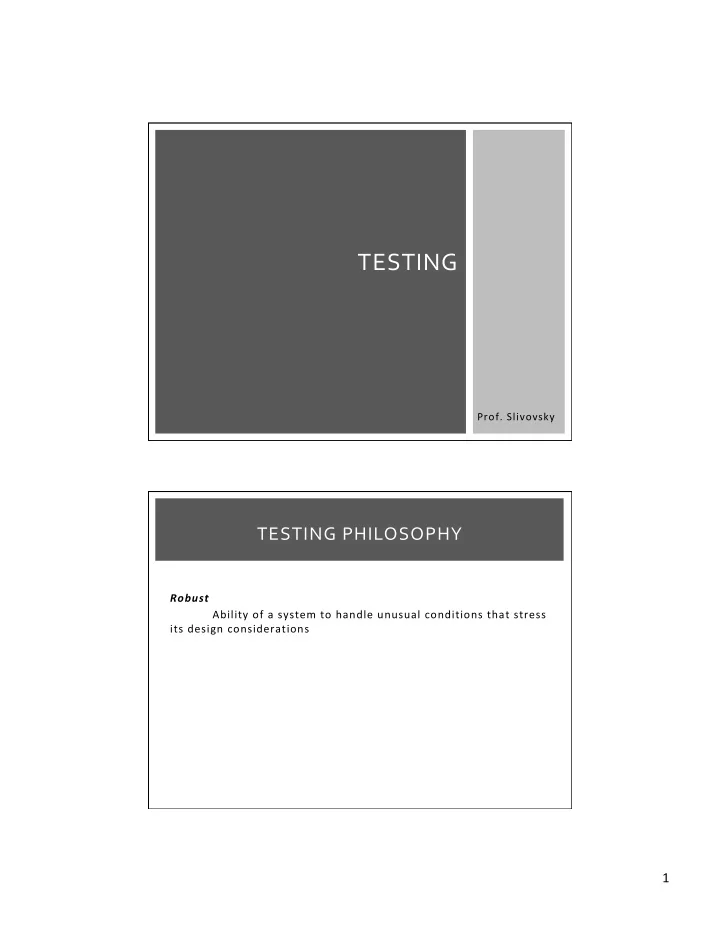

TESTING Prof. Slivovsky TESTING PHILOSOPHY Robust Ability of a system to handle unusual conditions that stress its design considerations 1
PARETO PRINCIPLE Effort Effect 20% 20% 80% 80% 20% of the input accounts for 80% of the output COMPONENTS OF A TEST PLAN ¡ Strategies § A, I, S, T (analysis, inspection, similarity, test ) § Unit, integration, function, system, acceptance § Regression ¡ Resources § Hardware, software, data, personnel, facilities ¡ Constraints, assumptions, risks ¡ Schedule, personnel, deliverables ¡ Project team responsibilities [1, 2] 2
TESTING FRAMEWORK ¡ Unit Testing § Validates each and every software subroutine, function, database, tables § Identifies logic/function errors early ¡ Integration Testing § Continually test as you integrate components and increase complexity § Validates interface compatibility § Approach with a mix of top-down and bottom-up testing [1, 2] TESTING FRAMEWORK ¡ Acceptance Testing § Demonstrates the system's ability to meet specifications ¡ Regression Testing § Conducted upon implementation of any system/software changes and dependent on the scope and/or impact of the changes [1, 2] 3
APP CRASH TESTING ¡ Normal conditions ¡ Long Run Time ¡ Random/Unexpected Input [3] MECHANICAL LIFE CYCLE TESTING ¡ Operational life expectancy requirement of 10 years ¡ Unfeasible to run a test for a decade ¡ Accelerate testing by increasing stress on system/component for shorter duration (e.g., cycles/sec, temperature, etc.) 4
TEST CASE SKELETON Test Case Name: Test_Name Requirement: requirement/user story/use case Component: object/function/procedure/component under test Setup: Safety: Procedure: steps to run test Pass Criteria: Expected Results: Observed Results: Status: pass, conditional pass, fail ASSIGNMENTS ¡ Test plan draft: DVP+R spreadsheet plus two detailed test cases ¡ Design Sprint #5: Complete Test Plan (DVP+R and detailed test cases) and testing results/analysis ¡ DVP+R skeleton, due dates/upload links on PolyLearn 5
RESOURCES ¡ “Some Resources for Learning how to Test Android Apps,” available at https://www.philosophicalhacker.com/post/some- resources-for-learning-how-to-test-android-apps/ ¡ ASME Standards & Certifications: Examples of Use of Codes and Standards for Students in Mechanical Engineering and Other Fields, (available at: go.asme.org/SCStudent) REFERENCES 1. ISO/IEC/IEEE 29119-2013 Software Testing 2. IEEE SA 829-2008 IEEE Standard for Software and System Test Documentation 3. Brandon Landis, “The Ultimate Guide To Snapchat In 2016 – Strategy, Tutorials, Case Studies, And More”, (available at: https://responster.com/blog/snapchat-guide) 6
Recommend
More recommend